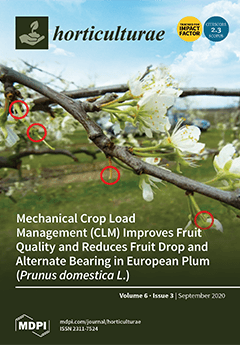A greenhouse study was conducted to assess the relative salt tolerance of 11 cultivars of hydrangea:
Hydrangea macrophylla ‘Ayesha’, ‘Emotion’, ‘Mathilda Gutges’, ‘Merritt’s Supreme’ and ‘Passion’;
H.
paniculata ‘Interhydia’ and ‘Bulk’;
H.
quercifolia ‘Snowflake’;
H.
serrata ‘Preciosa’; and
H.
[...] Read more.
A greenhouse study was conducted to assess the relative salt tolerance of 11 cultivars of hydrangea:
Hydrangea macrophylla ‘Ayesha’, ‘Emotion’, ‘Mathilda Gutges’, ‘Merritt’s Supreme’ and ‘Passion’;
H.
paniculata ‘Interhydia’ and ‘Bulk’;
H.
quercifolia ‘Snowflake’;
H.
serrata ‘Preciosa’; and
H.
serrata × macrophylla ‘Sabrina’ and ‘Selina’. Plants were treated with a nutrient solution at an electrical conductivity (EC) of 1.0 dS·m
−1, and nutrient solution-based saline solutions at an EC of 5.0 dS·m
−1 (EC 5) or 10 dS·m
−1 (EC 10). The study was repeated in time (Experiments 1 and 2). In both experiments, by the fourth week after treatment, ‘Bulk’ plants in EC 10 exhibited severe salt damage with most of them dead. ‘Interhydia’ was also sensitive, showing severe salt damage in EC 10 with a high mortality rate by the end of the experiment. The leaf area and total shoot dry weight (DW) of all cultivars in EC 5 and EC 10 treatments were significantly reduced compared to the control. Leaf sodium (Na
+) and chloride (Cl
−) concentrations were negatively correlated with visual quality, leaf area and shoot DW. The salt-sensitive cultivars ‘Bulk’, ‘Interhydia’ and ‘Snowflake’ had inherently low leaf Na
+ and Cl
− concentrations in both control and salt-treated plants compared to other cultivars. Salt tolerance varied among species and cultivars within
H. macrophylla. Among the 11 cultivars,
H. macrophylla ‘Ayesha’ and two hybrids, ‘Sabrina’ and ‘Selina’, were relatively salt-tolerant.
H. macrophylla ‘Merritt’s Supreme’ and ‘Mathilda’ were moderately tolerant.
H. paniculata ‘Bulk’ was the most sensitive, followed by
H. paniculata ‘Interhydia’, and then by
H. serrata ‘Preciosa’ and
H. macrophylla ‘Passion’, as evidenced by high mortality and severe salt damage symptoms.
H. quercifolia ‘Snowflake’ and
H. macrophylla ‘Emotion’ were moderately salt-sensitive.
Full article





